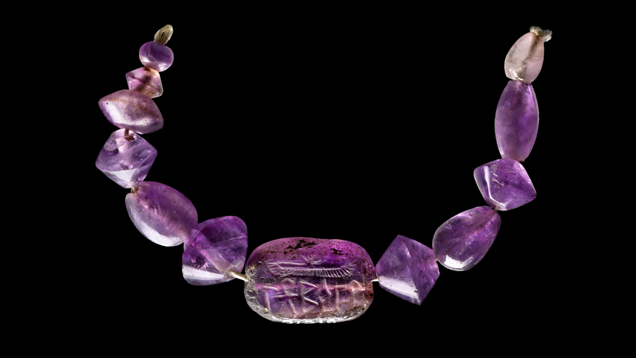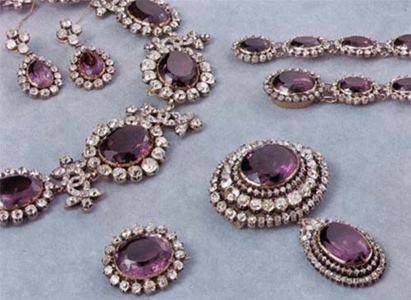Amethyst belongs to the family of quartz and has a purple hue, from light pink-violet to dark purple. It was called a-methystos because ancient Greeks and then Romans believed that this gemstone had the capacity to protect its owner from drunkenness. That's why Greeks and Romans wore amethyst jewellery, while decorating their utensils - mainly cups and jugs - with the same stone.
Later the amethyst gemstone was one of the beloved precious stones of Europe's royals and nobles and was used to build artworks and household utensils. Since the 18th century, however, its use has been focused on jewellery.
Amethysts rarely have a uniform color. They usually have spots of light or darker color, or both, or streaks of different shades. Unlike other gemstones, the value of the stone is not affected by its size but by its color, and stones that have a deep and intense purple color are rarer and therefore more expensive. Siberian Amethyst, the most sought-after amethyst due to its intense color, is produced in specific mines in Russia, Sri Lanka, and Brazil. Other areas with significant amounts of amethyst are Austria, India, and Zambia.
The Duchess of Windsor's Amethyst Necklace

Wallis Simpson, the wife of the Duke of Winsdor, former King of England, Edward, had acquired a very impressive amethyst necklace. At the heart of the gold necklace is a large heart-shaped amethyst surrounded by 27 step-cut amethyst, brilliant and turquoise stones. The necklace was auctioned in 1987, after the death of the Duchess, and its price reached $605,000.
Egyptian Amethyst Necklace
 Famous necklace with amethyst stones dating back to 2000 BC. There is an inscription of Egyptian writing dating back to the 8th century AD on the central stone, which is framed by smaller amethyst stones in irregular shapes.
Famous necklace with amethyst stones dating back to 2000 BC. There is an inscription of Egyptian writing dating back to the 8th century AD on the central stone, which is framed by smaller amethyst stones in irregular shapes.
Morris Amethyst Brooch

Amethyst set of the royal family of Sweden

Part of the Crown Jewellery of Sweden is an amethyst jewellery set that once belonged to Josephine, the Empress of France, (Napoleon's wife), and since 1823 belongs to the Royal Family of Sweden. The parure originally consisted of a necklace adorned with 15 amethyst gemstones, two bracelets, and a pair of earrings. Since the 1970s, the necklace has been turned into a tiara, while the two bracelets have been joined in a necklace.
The Kent Amethysts
 The jewellery parure known as Kent Amethysts belongs to the British royal family. Originally it was owned by the Duchess of Kent, Queen Victoria's mother, and the latter bequeathed the parure to the British Crown, after her death. The set was originally made up of a necklace, a pair of earrings, three pins, and a pair of hair combs that were fashionable back in the day.
The jewellery parure known as Kent Amethysts belongs to the British royal family. Originally it was owned by the Duchess of Kent, Queen Victoria's mother, and the latter bequeathed the parure to the British Crown, after her death. The set was originally made up of a necklace, a pair of earrings, three pins, and a pair of hair combs that were fashionable back in the day.
In recent years, it is speculated that the two pins and combs are embedded in the necklace.